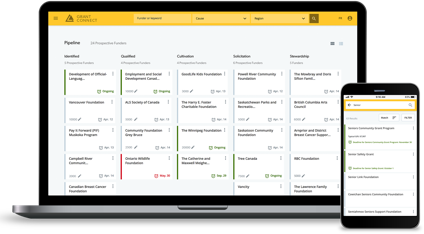We invite you to read the most recent version of this article, updated for 2024.
These exciting changes in philanthropy might lead to your most successful grant writing year yet.
Charities and nonprofits have needed to get creative with their fundraising in order to meet increased demand for services amid decreased capacity. As we head into more uncertainty with rising inflation, a looming recession, and the ongoing impacts of the COVID-19 pandemic, diversifying your revenue sources is one of the most important things you can do to ensure a sustainable future for your organization.
Garnering support from mission-aligned funding partners – whether they be foundations, corporations, government agencies, or other institutional donors – is a key piece of that revenue puzzle. We know how frustrating it can be when the challenges seem to outweigh the rewards – such as after a long string of grant rejection letters, or when systemic inequities stop you from getting the funding your organization needs, or when an exhaustive application for a tiny project grant makes you pause and ask: Is this really worth my time?
We’ve got good news for you: things are changing for the better in the philanthropic sector. From historic policy moves to transformative changes in grantmaking practices, these eight shifts could lead to increased returns on your organization’s grantseeking efforts – and to a more equitable and accessible funding landscape for the future.
1. Changes to the Disbursement Quota (DQ) will unlock more grant money for the sector.
As per the Federal Budget released in April 2022, the disbursement quota – the percentage that registered charities such as foundations are required to disburse each year toward charitable activities – is increasing from 3.5% to 5% on assets over $1 million dollars in January 2023. This is the first such adjustment in over 10 years, and its purpose is to ensure charitable donations are being actively invested into our communities. While Imagine Canada would prefer to see a scaled disbursement quota, the planned shift will most likely unlock a significant amount of grant money. Our research shows that if the disbursement quota had been 5% instead of 3.5% in 2019, approximately $500 million additional dollars would have been available to the sector – mostly from the assets of private foundations. With increases in foundation assets since then, that figure could be even greater in 2023 and beyond. Pay attention to the size and number of gifts being given by larger foundations in the coming year. (There are tools that can help you with this!)
2. More funders are being intentional about supporting underfunded groups.
The sector is becoming more conscious of the barriers faced by equity-seeking charities and nonprofits, such as those led by and serving people from Black and Indigenous communities. Some funders have been taking proactive steps to better support these organizations and the communities they serve.
Community foundations, like Toronto Foundation and Community Foundations of Canada, have recently created or facilitated funding streams designed for and with Black and Indigenous communities, as have government-supported initiatives such as Ontario Trillium Foundation and New Relationship Trust. Corporations and their foundations, including Bell Canada, TELUS, and the NBA Foundation, are dedicating funding to Black and Indigenous organizations for causes like literacy, mental health, and community resiliency.
Alongside commitments to equity-seeking groups, funders like the Vancouver Foundation and the National Centre for Truth and Reconciliation are reducing barriers in the application process by permitting oral or video-based applications. This creates access for people with disabilities, people who follow oral traditions of knowledge-sharing, and organizations lacking the administrative resources for traditional grant writing.
The creation of the Foundation for Black Communities, Canada's first-ever philanthropic foundation dedicated to investing in Black communities, is a major step toward change in a philanthropic landscape where white supremacy runs deep.
3. Organizations without charitable status will soon be eligible for more grants than ever before.
Another recent policy victory for grantseekers is the amendment of outdated regulations that have restricted registered charities (such as foundations) from funding groups without charitable status. Many non-charities, such as grassroots groups, mutual aid networks, and some Indigenous and First Nations bands, carry out vital services in equity-seeking communities across Canada.
Thanks to the advocacy of Senator Ratna Omidvar, of charities and non-charities, and of Imagine Canada (for whom amending this legislation is a key policy priority), new rules outlined in Bill C-19 will lead to charities being able to disburse funds to non-charities without subjecting them to the “direction and control” legislation which has long stood in the way of equitable partnerships between these groups.
Nonprofit organizations without charitable status may soon be eligible for funding that was previously off the table, while charities might encounter new opportunities to innovate and fulfill their missions in concert with a non-charity partner. Follow our Early Alert newsletter for updates on the rollout of these changes!
4. Trust-based philanthropy is on the rise.
If you’re getting fed up with overly restricted funding, super-short-term project grants, and reporting requirements that make you feel like you’re on trial, you’ll be happy to hear that funders are increasingly embracing the concept of trust-based philanthropy – an approach that helps advance equity, shift power, and build mutually accountable relationships by grounding philanthropy in trust-based values.
The rise of trust-based philanthropy is partly due to the COVID-19 pandemic and the rapid changes in community needs that ensued. Funders releasing emergency aid had to trust, to an extent, that organizations knew how best to use those funds to support their communities (as well as what they need operationally in order to keep doing so). Charities and nonprofits who had cultivated strong and authentic relationships with funders had an easier time garnering that trust in a time of crisis.
Some funders, like the Victoria Foundation, are retaining those trust-based values for the future in order to make their funding more accessible, equitable, and supportive of their community’s long-term wellbeing. Imagine Canada is also advocating for trust-based relationships between community organizations and government funders.
As trust-based philanthropy continues to take root, charities and nonprofits can anticipate more funders offering flexible, unrestricted, or multi-year funding, and streamlining their reporting requirements by grounding them in trust alongside accountability – all with an eye toward alleviating power imbalances between funders, organizations, and communities. Read our recent report to learn more about trust-based philanthropy and unrestricted funding.
5. Donor-advised funds are more accessible (and lucrative) than ever.
By 2026, Canadian donor-advised funds (DAFs) are projected to value approximately $10 billion, compared to $5.7 billion in 2018. Wealthy donors look to DAFs as a means of investing in their communities while bypassing the administrative labour that comes along with managing charitable funds.
While some DAFs have been on the receiving end of criticisms around lack of transparency and the potential for tax sheltering, the influx of dollars into DAFs means that they have resource potential grantseekers should not overlook – especially as the disbursement quota rises. Some foundations with donor-advised funds, like Toronto Foundation and Calgary Foundation, make a point of introducing their donors to a wide range of prospective grantee organizations in order to diversify their funding and encourage an equity lens. Most fundraising involving DAFs will require building personal relationships with donors themselves, but others such as Nanaimo Foundation and Ottawa Jewish Community Foundation are open to proposals. CanadaGives, one of the largest DAFs in Canada, currently accepts applications to twelve of their managed funds via Grant Connect exclusively.
6. Corporations are more invested in social impact than ever.
In response to the social crises of the last few years, the world increasingly expects companies to deliver both economic and social value. Employees are also beginning to feel more strongly that their employers should have a positive impact on their communities – and factoring corporate social responsibility into their choices about where to work. This and the rise of ESG investors has translated to a proliferation of corporate social impact programs, as well as a rise in employee giving programs.
The funding priorities of corporations are diverse and timely, from climate change (TD, Google) to employment (The Co-operators, Desjardins Group) to event sponsorships and small community grants. Depending on where the funding is coming from in the corporation’s budget, they may also be open to giving to non-charities, such as through “neighbourhood grant” programs at local credit unions.
Companies are becoming more creative in how they can support communities as well, often granting in-kind products and services in addition to money. Google’s Climate Innovation Challenge named above is an example of in-kind services directly embedded into funding programs, while corporations like Hydro-Québec make their employees’ time and skills available in-kind to supplement other support.
You don’t have to be a large or far-reaching organization to receive funding from a corporation. Many corporations are more concerned with meaningful local impact and values alignment than with widespread brand visibility. All in all, as we look toward recovery from the impacts of the pandemic, corporations and social impact organizations of all sizes have a unique opportunity to unlock new solutions through meaningful partnerships. Read our report to learn more!
7. The pandemic isn’t done with us, and funders know it.
While we all wish COVID-19 were a thing of the past, the pandemic and its far-reaching social effects are very much still with us. The services of charities and nonprofits remain in high demand as social institutions like healthcare and education remain under great strain, all of which is exacerbated by burgeoning economic crises.
While some of the emergency funding streams from the early pandemic have now ceased, new funds in support of pandemic recovery continue to emerge – especially from government sources.
Some examples include:
- Canadian Red Cross recently completed an application intake for a new grant program intended to assist community organizations in supporting those whose mental health and wellbeing have been disproportionately impacted by COVID-19.
- New Relationship Trust’s Indigenous Resilience and Recovery Grant is open to applications from Indigenous nonprofit organizations that have been disproportionately impacted by COVID-19 and continue to face funding and operational challenges in their post-pandemic recovery.
- The Government of Canada’s Community Services Recovery Fund will open soon to help charities and nonprofits adapt and modernize as part of their recovery from the pandemic.
- The Ontario Trillium Foundation’s Resilient Communities Fund has opened again to support organizational recovery from COVID-19.
- Alberta Blue Cross’s COVID Community Roots program remains open to support community services as we move through the pandemic.
If you’re not signed-up for Grantseeker (our free, monthly fundraising newsletter) or our Grant Connect subscriber-exclusive Funder Alert, subscribing to those newsletters will help you keep track of these COVID-related funding opportunities when they arise.
8. You have access to more data than ever to inform your strategy.
In a time of limited administrative resources and increased need for funding, it might be tempting to adopt “spray and pray” as your top fundraising strategy. However, data about funders, giving history, and nonprofit sector trends is easier than ever to access – which in turn makes it easier to be intentional about your applications and make strategic decisions about who to approach.
One of the reasons Imagine Canada advocates for a home in government for the charitable and nonprofit sector is to ensure more consistent sector data collection and analysis. Imagine’s research team also carefully monitors the sector in order to help nonprofit leaders and fundraisers stay informed, plan ahead, and bolster their cases for support.
Detailed gift history for individual foundations and other charities is available through the Canada Revenue Agency’s T3010 finder, and federal government gift data for many funding programs is available through their open data initiative. Data sets like this are incorporated into centralized platforms like Grant Connect, where they are cleaned and compiled so they can be easily interpreted. Information is power, and having access to more information than ever puts power back into the hands of fundraisers as you decide how to spend your grantseeking budget.
Prospecting and grant writing can be a lonely job, but you’re not alone. All across the sector, funders, charities, nonprofits, sector advocates, and policymakers are working together toward a more sustainable and equitable future. Though there’s much more work to be done, the developments we have outlined here are signs of progress toward a philanthropy built on trusting relationships, authentic communication, inclusivity, and transformative social change.
Happy fundraising!
Are we missing any great new trends or developments in grantseeking that you think we should know about? Want to share an opinion or a success story? We’re all ears! Email us.
Additional Resources
Diversifying Your Nonprofit’s Revenue: How You Slice the Pie Matters - Nonprofit Hub (English only)
Budget 2022: A Plan to Grow Our Economy and Make Life More Affordable - Government of Canada (Bilingual)
Unfunded: Black Communities Overlooked by Canadian Philanthropy - Foundation for Black Communities (Bilingual)
Trust-Based Philanthropy Project: Trust-Based Values (English only)
How Trust-Based Values Can Transform Philanthropy - Candid Philanthropy News Digest (English only)
20 Subtle Ways White Supremacy Manifests in Nonprofit and Philanthropy - Nonprofit AF (English only)
The Nonprofit Starvation Cycle - Stanford Social Innovation Review (English only)
The Rise of the Corporate Social Investor - Stanford Social Innovation Review (English only)




